Photomicrography
trials using a Nikon D50 on a
LOMO Biolam microscope with electronic flash
by David Walker, UK
I
recently bought Nikon's 'entry level' D50 digital SLR for general photography but was also interested to see how it performed on a LOMO microscope
as
my present digital imaging route with a Sony S75 digicam wasn't ideal.
Flash
was used exclusively to bypass the potential vibration problems of a camera directly
coupled to the microscope. Camera shake can
apparently remain a problem even with mirror lock, as my brother's
trials of a Canon 350D on a Zeiss Axiostar have
shown, so the vibration of a D50 which has no mirror lock on a
lightweight LOMO microscope could be worse. The flash set-up was described in last month's Topical
Tip.
I
used a very simple monocular set-up which I was familiar with
for both a film camera and consumer digicam. I like the
simplicity of this set-up for static subjects despite the potential critical
focussing problems and is also one other users of older microscopes
may be presented with because maker's photo equipment was either never available or hard
to source. I have
recently acquired the LOMO trino' head secondhand after many years looking (thanks Mark!), which should
be a better final solution but I was still 'finding my feet' with this.
|
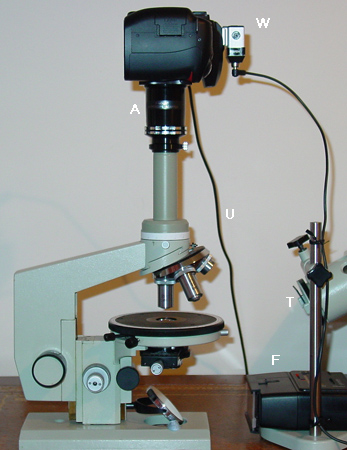
|
Ideally a sturdy camera mount independent of the microscope is preferred,
but as the the desk has to be
used domestically after microscopy it's more practical
to couple camera to the microscope.
F
- SunPak 2400 flashgun, an old but powerful and versatile
with 6 power settings. One
or two SunPak diffusers were used on the flashgun to remove residual light
banding caused by the reflector structure. The condenser was just slightly
defocussed on light source so essentially the lighting was critical illumination.
This was a superior light source to tungsten lighting with the LOMO lamps which
invariably needed a diffuser below condenser to achieve even lighting at low
to mid powers.
W
- Wein Safe-Sync adaptor. (The
measured trigger voltage on the charged SunPak sync port was ca. 250V, which
is Nikon's highest recommended voltage, assuming polarity was also
correct; such voltages could potentially fry a camera's electronics if
mismatched, the Wein SafeSync is a safe way of syncing such flashguns.)
T
- LOMO OI-19 tungsten lamp.
U
- Nikon supplied USB 2.0 cable to PC allows immediate image transfer
to study on CRT monitor.
A
- 35mm photomicrography adaptor. This is one of the shorter third
party designs
and the small projection distance partly compensates for the more limited
field of a DSLR. A LOMO compensating or non-compensating 7x normal
eyepiece was used depending on objective.
|
|
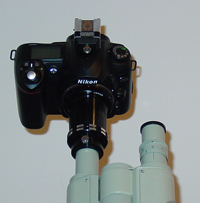 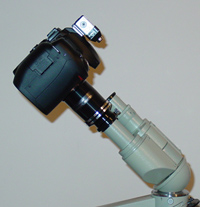
|
For microscopes
without vertical tube, the lightweight and compact D50 body does
not rule out using it on the LOMO binocular head, ensuring all
couplings are secure! The camera weight does not affect the Biolam's
stability. Flash would be better than tungsten to remove vibration
problems.
With interocular distance
set at max, visual checking of the view in other eyepiece is just about
doable, perhaps even allowing a set-up for parfocality ... another
project!
|
Ergonomics:
With flash, once the shutter speed has been chosen, there's no exposure controls on camera
other than shutter release that are used. If tungsten was used, the setting of shutter
speed and self timer could be more awkward as the top LCD status panel (not
illuminated) is harder
to access and view. The angled set-up on bino' head would allow easier camera control in
this
aspect.
With
a small microscope like the LOMO Biolam, the LCD image review
screen is at a good height to allow gross exposure / focus problems
with the image review features.
Focussing: It's a pity the clear centre with split screen has been
lost on most DSLR viewfinders as did find it invaluable on my Nikkormat
35mm SLR.
Focussing is certainly trickier with the D50 coarse screen but my success
rate seemed quite good, apart from at the lowest mag of 3.5x where depth of
focus at sensor plane can be very small. Camera focus was only a slightly off
the visual focus so shouldn't unduly affect image quality.
Flash negates the need for self timer, delayed release
etc, allowing images to be taken as fast as the shutter was fired. For
subjects / mags where
critical focussing was tricky with the camera viewfinder it was possible
to routinely make a few fine focus increments either side of visual focus for
immediate inspection of images either on the PC or zoom function on LCD. One or more images
with different planes in focus could also be stacked with software like CombineZ
or Helicon Focus. In fact Helicon Focus
was my preferred software for first check of all images read off the
card even if no plan to stack, as they are presented in a quickly accessible
file sequence and window for checking e.g. critical focus rather than the
awkward tiling etc of Photoshop or file browsers.
Nikon
Capture software: A 30 day trial is included which gives the user the chance
to decide if the remote camera control / direct image transfer bypassing
card
/ RAW file editing is vital. It typically costs £120 extra in the UK so for
the present I'm living without it.
RAW files can be opened in Photoshop Elements 3 albeit losing RAW parameters.
At time of writing Photoshop CS2 has yet to release a RAW plug-in that supports
the D50 but shouldn't be long. Update
Oct 2005: the
latest CS2 RAW plug-in does now support the D50. (Note that
Nikon Capture does allow remote shutter release of D50 when no CPU lens
is attached, whereas rather curiously the Canon 350D doesn't from my brother's
trials even though the Canon supports metering with lens free photography.)
Image
capture / transfer / work-up: after some trials these settings suited
my set-up.
Camera
settings: flash white balance, ISO 200, shutter sync 1/250 (1/500 max),
shutter button pressed manually.
Images saved to card as either 'RAW + basic jpeg' for quality work
but most of time preferred just 'fine jpeg'. The image quality difference is
subtle unless using full size.
Camera connected
by USB 2.0 cable to PC allows access to files on D50 card immediately after
taking, but found that a PC connection loses the image review on LCD so preferred
to store on card without a PC connection for LCD image review.
Sensor
size and field of view: The D50, as with other consumer DSLR's, has a sensor
which typically gives a 1.5x mag. factor cf 35 mm film, so when used with film
photomicrography adaptors it
gives a proportionally smaller field of view. However,
many hobbyists like myself use either the older or less than finest microscope
optics which may not be well corrected for either field flatness or aberrations
towards the edge, so using a smaller field
is arguably a benefit (I've also yet to source suitable photoeyepieces for the
LOMO). With the speed of image editing nowadays a few image auto-stitches
of static subjects can restore an effective 35 mm field of view
if required.
Exposure
determination: Metering is not possible with the D50 without a lens on,
unlike the Canon 350D. This didn't proved to be a problem as after a few trials with different lighting
techniques and objectives, suitable flashgun power settings / diffusers
/ ND filters required were quickly established. Coupled with the instant review
of results on LCD and histogram / highlight warning, slight tweaks to the exposure
could readily be made. With live subjects a correct exposure for the lighting technique would need to be preset although saving results as a RAW file allows
a useful exposure latitude if needed.
A
selection of images are shown below with further notes on how the
microscope / camera performed.
Images
Work-up:
levels and contrast adjustment in Photoshop Elements if needed, these were usually
minor changes. A resize
from 6 Mpixels used Fred Miranda's 'WP Pro' with 'low sharpening' unless stated
otherwise. Fine jpeg setting at full resolution used in camera not RAW.
Eyepiece
was LOMO 7x or K7x as appropriate.
Flash head had 24mm lens diffuser and
ND4 filter attached. Flash power varied between 1/2 and 1/32.
Objective:
LOMO 3.5x/0.10 planachro
Critical focusing was, as expected, hardest at this
lowest mag through viewfinder because of low depth of focus at image plane.
I rarely got a very crisp image and downsampling with 'WP Pro' 'high sharpening'
was required.
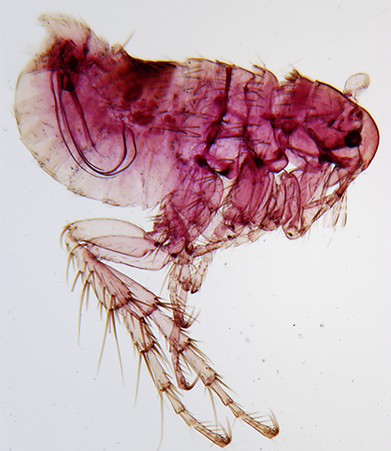
Hedgehog
flea. Biosil slide.
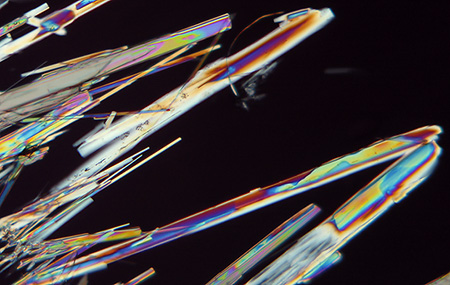
Mannitol,
crossed polars. Blacks
seemed good out of the camera with only slight
tonal balance correction afterwards.
Objective:
LOMO 9x/0.20 planachro.
Focussing was easier with this objective.
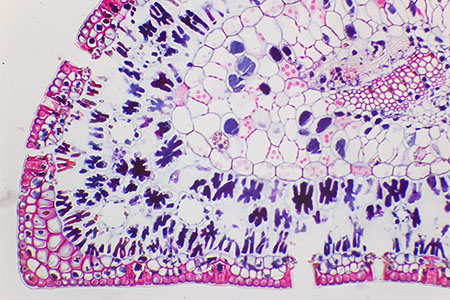
Maritime
pine, stained T/S leaf, Biosil slide.
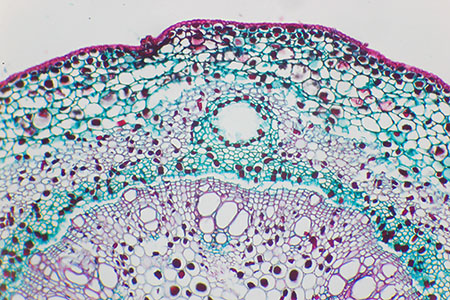
T/S
stained cashew leaf, Biosil slide.

Radiolaria,
Bermuda 'Collection Albert Renaud' The mountant colour gives the warm tone.
Darkfield
homemade stop, as with polar, blacks seemed good out of the camera with only slight
tonal balance correction afterwards.
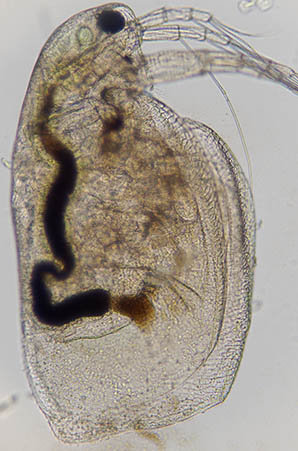
Live
Daphnia. If live subjects are immobilised the monocular set-up although not
ideal is usable. Both the 3.5x and 9x LOMO objectives can be used without eyepiece
but need a ca. 11 mm stop at eyepiece level to stop flare which also gave some
vignetting, but did increase the field somewhat as here for larger subjects.
Objective:
LOMO
85x achromatic NA1.0 water immersion.
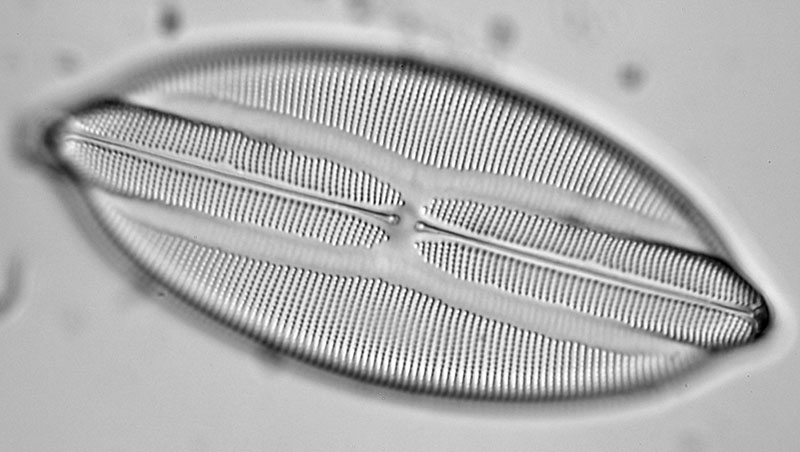
Diatom,
Navicula
lyra.
Klaus Kemp eight form test slide. 3 mm oblique on LOMO
aplanatic condenser.
Critical
focussing at this high mag was possible with viewfinder, but took a
few tries sometimes. It was more successful than at lowest mag probably because depth of focus
at image plane is higher (as distinct from depth of field at subject plane). The
LCD preview with zoom was usually enough to check if focus good enough. The
gritty look isn't noise but the flash emphasises any texture in light path. Out of
camera these images are very flat but contrast and level adjustments can bring
some punch back.
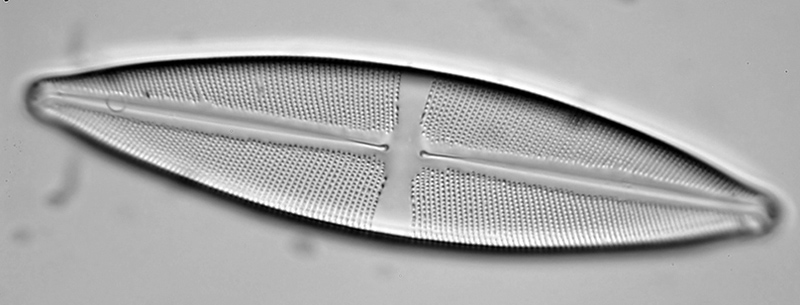
Diatom,
Stauroneis phoenocenteron, Klaus Kemp eight form test slide. 3 mm oblique on LOMO
aplanatic condenser.
The flash has plenty of power at high mag, it was set at 1/8th power,
with ND4 filter and '24mm' diffuser on flash gun.
Neat Image was used here
to remove some of flash grittiness.
General
comments: The six megapixel Nikon D50 and Biolam with monocular tube gives a simple
set-up with vignette
free imaging cf
my digicam route and relay lens. My
main interest in this trial was to determine whether removal of 14 elements
of glass between eyepiece and sensor by going from S75 digicam with reversed
50mm relay lens to D50 gave a good step up in image quality. My impression is
not really; the S75 gives contrasty, crisp images and easier to
focus. The S75
sensor is also sealed cf the DSLR and gives easier live focussing on back LCD
with low mag objectives. Although the less awkward set-up and lack of vignetting
makes me favour the D50 set-up somewhat, I am a bit wary of the increased exposure of a
DSLR
camera
internals to dust, potentially increasing dust on sensor problems, time will
tell.
However, the D50 is somewhat of
an overkill for
modest LOMO optics; large prints are the main draw of multi megapixel cameras but
most of the photomicro' images from my set-up aren't good enough to exploit the images at full
res. For screen use or small prints, downsampling and sharpening can rectify
this.
For
those with a very good photomicroscope set-up with high quality optics the D50 should
be capable of getting the most out of the optics as the lack of metering and mirror lock is readily
circumvented, in this case with a flash system.
Comments to the
author
David
Walker
are welcomed.
© Microscopy UK or their contributors.
Published in the September 2005 edition of
Micscape.
Please report any Web problems or offer general comments to
the
Micscape
Editor
.
Micscape is the on-line monthly magazine of the Microscopy
UK web site at
Microscopy-UK
© Onview.net Ltd, Microscopy-UK, and all contributors 1995
onwards. All rights reserved.
Main site is
at www.microscopy-uk.org.uk
with full mirror
at www.microscopy-uk.net
.










